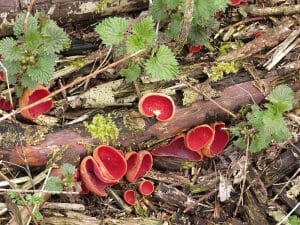Endophytic fungi live inside of plant tissues but don’t cause any disease symptoms. They are found in all plant species including deciduous trees, shrubs, marine algae, mosses, lichens, ferns, grasses and palms. Endophytic fungi produce secondary metabolites that keep herbivores from eating the plant by making it poisonous or taste bad and they have other key roles in nutrient uptake, heat tolerance, plant evolution and biodiversity.
There are two major categories of endophytic fungi, balansiaceous (associated with grasses) and non-balansiaceous. These categories are further subdivided into four classes I-IV. The endophytic fungi in Class I produce chemicals that are toxic to animals, increase plant biomass and make plants drought resistant. Class II comprises rare species of mycorrhizal fungi that help plants tolerate habitat-related stress. A single plant may have hundreds of species of Class III endophytic fungi. This class colonizes only above-ground plant tissues and are found on deciduous trees, vascular and nonvascular plants, woody plants and herbaceous angiosperms. Class IV endophytic fungi live only on the roots of plants found in the arctic, Antarctic, alpine, subalpine and tropical ecosystems.
The secondary metabolites from endophytic fungi lead the way as sources for new drugs and therapies. One of the earliest discoveries was penicillin isolated from the fungus Penicillium notatum in 1928. In the 1990s, the anti-cancer drug Taxol was developed from Taxus brevifolia the Pacific yew tree. Other examples are the anticancer drug vincristine developed from the endophytic fungi Mycelia sterilia which grows on the rosy periwinkle plant. Another example is Clavatol, an antimicrobial produced by the fungus Aspergillus clavatonanicus which grows on coniferous trees.

The image above shows the scarlet elfcup, Sarcoscypha austriaca, a fungus belonging to the phylum ascomycetes which contains many species of endophytic fungi.
References
- Mishra, Y., Singh, A., Batra, A. and Sharma, M. M. (2014). Understanding the biodiversity and biological applications of endophytic fungi: A review. J. Microb. Biochem. Technol. S8: 004.
Endophytic Fungi
No comments:
Post a Comment